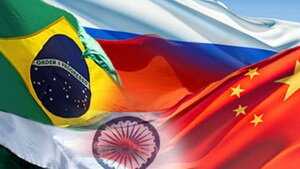
In its previous publications on economic issues “Borysfen” analyzed the state of and prospects for the economic development of the European Union. In the context of comparisons, economic trends in the other group of countries, with so-called "transition" economies - namely Brazil, Russia, India, China and South Africa (Group BRICS) are interesting. In recent years, they have been showing relatively high rates of economic growth (at 3-8%) that exceeds the index of leading European countries - France and Germany (within 0.2-0.8%).
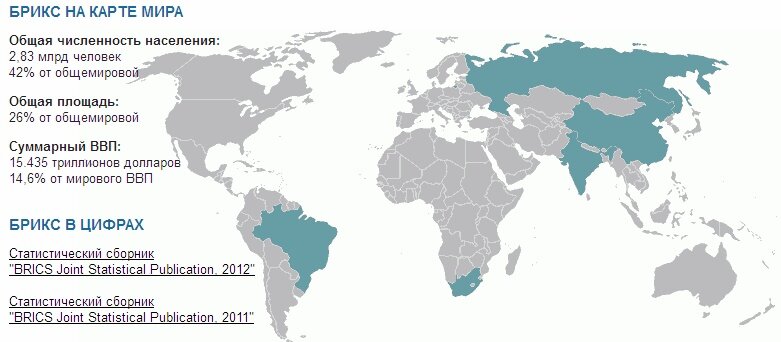
|
| BRICS on the world map http://iport.info/blogs/bolshoj-evrazijskij-soyuz-shosodkbbriks/ |
According to leading experts, the reason is in peculiarities of economic activity of BRICS, including cheap labor and relatively low social expanses that promote exports of domestic production and avoid significant state budgets’ deficits. More so, a significant advantage of these countries (primarily Russia) is their possession of large reserves of natural resources (including energy carriers), which allow to satisfy their own needs, and to take advantage of their export.
But despite their relatively high rate of economic development, BRICS countries have several problems that don’t allow to fully realize their economic potentials and, in some cases, reduce the rate of economic development. First of all it concerns the stagnation of foreign markets of these countries, as well as reducing foreign investments due to the complexity of the economic situation in the U.S. and the European Union. Moreover, another problematic factor is means of the leadership of PRC, deliberately holding back the growth of the Chinese economy (through its "overheating"), which serves as one of the "drivers" of the economies of BRICS countries.
It should be noted that each BRICS country has its own characteristic features, including:
 [1] China (holds the position of the leader in the group) - has one of the most powerful economies in the world with high rates of growth (about 9% in 2011 and 8% in 2012). Thus, according to the international consulting firm PricewaterhouseCoopers, with its economic potential, China can overtake the U.S. within the next four years. In particular, by 2017 China's GDP will be 20 trillion US dollars (by purchasing power parity), that exceeds the corresponding index for the USA, and by 2030 - about 30.6 trillion US dollars. At this, according to the Ministry of Commerce of China, in 2012, China had outpaced the United States in terms of foreign trade, having reached a level of 3.87 trillion US dollars, while the average rate in the United States is 3.82 trillion US dollars.
[1] China (holds the position of the leader in the group) - has one of the most powerful economies in the world with high rates of growth (about 9% in 2011 and 8% in 2012). Thus, according to the international consulting firm PricewaterhouseCoopers, with its economic potential, China can overtake the U.S. within the next four years. In particular, by 2017 China's GDP will be 20 trillion US dollars (by purchasing power parity), that exceeds the corresponding index for the USA, and by 2030 - about 30.6 trillion US dollars. At this, according to the Ministry of Commerce of China, in 2012, China had outpaced the United States in terms of foreign trade, having reached a level of 3.87 trillion US dollars, while the average rate in the United States is 3.82 trillion US dollars.
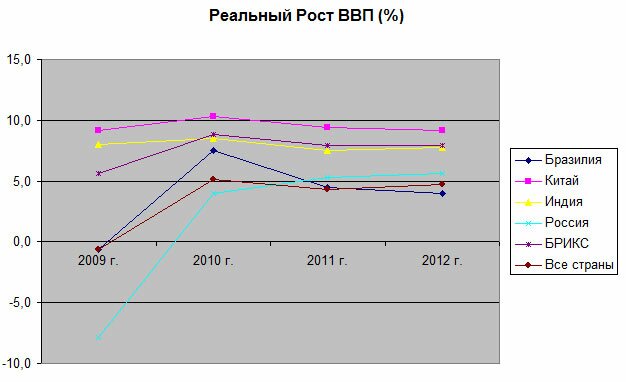
|
|
Real GDP growth (%) http://www.spa.msu.ru |
Note that the essential problematic factor in the economic development of China is mainly the export orientation of the economy. This makes it overly dependent on the situation at foreign markets. Technological lagging behind the leading Western countries and a worse quality of Chinese products, strengthening of credit and debt problems within China (the inability of enterprises and provincial governments to pay for loans from state banks), the imbalance of economic state of eastern (coastal) and central and western Chinese provinces - also bring about changes in the Chinese economy.
With all this in mind, the leadership of China tries to prevent worsening of the economic situation in the country, focusing on creating conditions for increasing domestic demand for products made in China that will compensate for decline in its exports. For this purpose, they plan measures to increase the purchasing ability of the Chinese population (increasing wages and social expanses). Besides, they plan restructuring of the banking sector that will solve the problem of domestic debts.
In the opinion of the Chinese leadership, more foreign companies will come to work in China (especially in the high-tech sector), in the result of the liberalization of the Chinese economy, including the weakening of state control over its work. Importance is also given to increasing energy security of the country. To do this, China will try to get a wider access to oil and gas fields in other regions of the world (especially in Africa and Central Asia), and to introduce new technologies of slate hydrocarbons production at its own territory.
China will play a role the savior of Europe
But even this, according to Western experts, will not save the Chinese economy from a "failure” within the nearest few years. Thus, the PRC government has reduced the pace of the economic growth of the country (approximately to 7%) to prevent overproduction of goods.
 India (holds the second place in BRICS for its economic potential) - maintains a relatively stable economy with positive dynamics of development and high investment opportunities. According to the Ministry of Finance of India, in 2012 the growth in Gross Domestic Product was 7.4%, and the total accumulated investments reached about 30% of the GDP. At this, according to the forecasts of world expert agencies, by 2030 India may go to the third place in the world (after China and the U.S.) in terms of GDP - at the level of about 14 trillion US dollars.
India (holds the second place in BRICS for its economic potential) - maintains a relatively stable economy with positive dynamics of development and high investment opportunities. According to the Ministry of Finance of India, in 2012 the growth in Gross Domestic Product was 7.4%, and the total accumulated investments reached about 30% of the GDP. At this, according to the forecasts of world expert agencies, by 2030 India may go to the third place in the world (after China and the U.S.) in terms of GDP - at the level of about 14 trillion US dollars.
All this allows India to successfully reach its goals in the political, economic and security spheres, and also contributes to the transformation of the Indian state into an attractive partner for other countries.
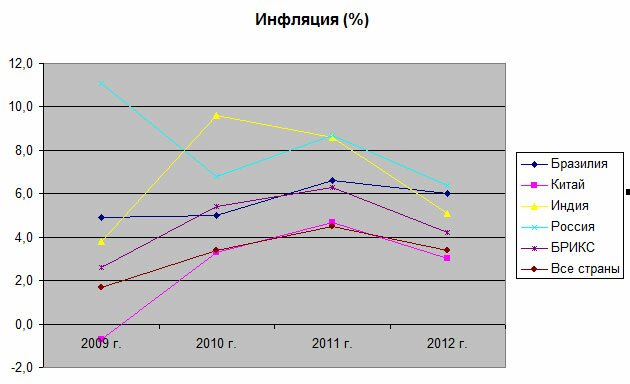
|
|
Inflation rate (%) http://www.spa.msu.ru |
At the same time, the pace of India's economic growth is slowed down by the government’s being unable to introduce effective economic reforms (high bureaucracy of the government and its excessive interference in Indian economy); inefficiency of Indian legislation in the investment sphere; a poor development of the transport infrastructure; deficit of skilled personnel; difficulties connected with the redistribution of resources between the unproductive agriculture and high-tech industries, as well as substantial lagging behind the leading Western countries.
The mentioned above circumstances and negative external effects lead to a drop of pace in the economic development of India, which in 2013 is expected at the level of around 5.7%. Besides, worsening of the foreign trade balance of India and increase of deficit of the state budget due to the fall of demand for Indian goods, are forecasted by economists.
Trying to deal with these problems, the Indian government cares about improving the investment climate in the country and access to advanced technologies through the implementation of joint projects with leading Western countries (including the energy and military-technical spheres).It also takes measures to raise the role of India in the economic development of the Eurasian region through the country's participation in the creation of the so-called "New Silk Road", which is to join Southeast Asia, Central Asia, the Middle East and Europe as part of an integrated transport system. Indian leadership also cares about saving budget money.
 Brazil - maintains positive trend in the development of the national economy, however, has a number of significant problems due to negative external influences. First of all it concerns reducing imports of Brazilian goods by Argentina and China (due to their own economic problems), which are the main trade and economic partners of Brazil.
Brazil - maintains positive trend in the development of the national economy, however, has a number of significant problems due to negative external influences. First of all it concerns reducing imports of Brazilian goods by Argentina and China (due to their own economic problems), which are the main trade and economic partners of Brazil.
As a result, over the past two years the growth rate of GDP declined from 2.7% in 2011 to around 2% in 2012. In this situation, the government was forced to spend foreign exchange reserves of the country in order to support the national economy, which helped avoid even greater economic problems.
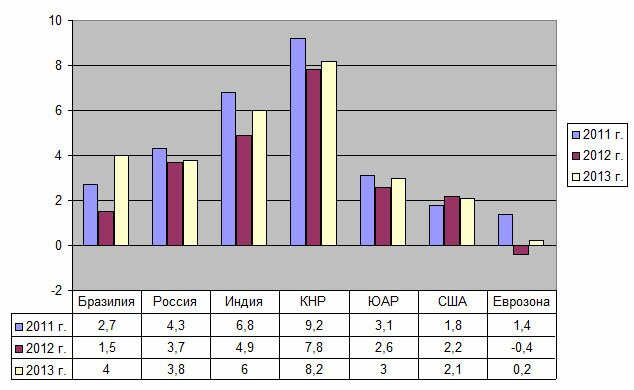
|
| Dynamics of changes in GDP of BRICS, 2010-2013. (in% to the previous year, 2012-2013. - forecast) http://www.spa.msu.ru |
Trying to stabilize economic processes in the country, the leadership of Brazil takes the following measures: mitigation of monetary policy (lower rates on loans); implementation of plans of public procurement to support domestic industries; optimizing fiscal policy (tax cuts for real manufacturers); attracting private funds to modernization and development of the transport infrastructure (including roads and airports).
Great attention is paid to increasing the volumes of production and refining of oil in the country through the development of new oil fields and construction of oil refineries. Special attention is paid by the government to improving the efficiency of agriculture (one of the leading sectors of the Brazilian economy) through more efficient use of land and introduction of new technologies.
According to international consulting agencies, the mentioned above measures will enable Brazil to increase its GDP to around 4% already in 2013 and held the figure at that level in the years that follow.
 South Africa has a significant economic potential, but is in a very difficult situation because of the negative impact of both, external and internal factors. The main problem of the economy of South Africa is the lower external demand for the national economic complex’ production, which is mainly of raw character (the main sections of South African exports are iron and steel products). As a result, GDP growth fell from 3.1% in 2011 to 2.5% in 2012, in addition to an increase of the country's budget deficit and public debt (50% of GDP). Significant negative factors in South Africa are also inefficient state management of the economy (excessive number of control structures, corruption and lack of transparency in the work of the government); aggravation of contradictions between different political forces in the parliament and the government, lack of qualified personnel, poor development of transport and energy infrastructures.
South Africa has a significant economic potential, but is in a very difficult situation because of the negative impact of both, external and internal factors. The main problem of the economy of South Africa is the lower external demand for the national economic complex’ production, which is mainly of raw character (the main sections of South African exports are iron and steel products). As a result, GDP growth fell from 3.1% in 2011 to 2.5% in 2012, in addition to an increase of the country's budget deficit and public debt (50% of GDP). Significant negative factors in South Africa are also inefficient state management of the economy (excessive number of control structures, corruption and lack of transparency in the work of the government); aggravation of contradictions between different political forces in the parliament and the government, lack of qualified personnel, poor development of transport and energy infrastructures.
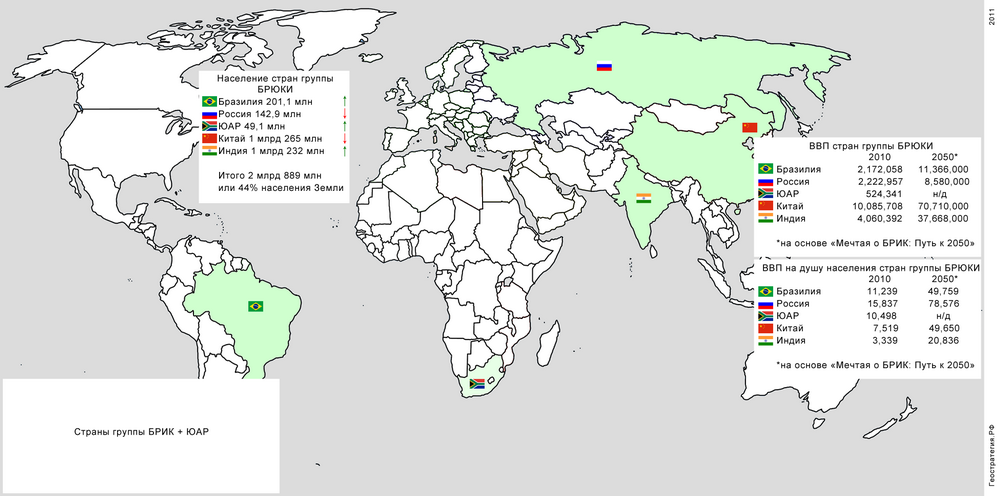
|
|
Characteristics of the BRICS group http://panslavist.ru |
In the process of solving the mentioned above problems, the government of South Africa takes steps to maintain private businesses, widely attracts foreign investments, stimulates financial spheres, as well as develops the national transport infrastructure. Attention is paid to the process of forming the "middle class", which is to expand domestic consumption and trade. The main expectations of the leadership of South Africa are for gradual recovery of the world economy and, consequently, increasing demand for the production of the national economy. This will increase the growth of the rate of GDP in 2013 to 4% and will retain this indicator at this level in the coming years.
 Russia, despite its potential, by its economic prospects is considered an outsider of the BRICS group. It keeps mostly raw materials (energy carriers) character of its economy, which makes it dependent on the current situation at the world markets. Thus, due to the reduction in imports of Russian energy carriers and other raw materials by trading partners of Russia (especially by the EU and China), Russia's GDP growth fell from 4.3% in 2011 to 3.5% in 2012 and is forecasted to remain at this level in the years that follow.
Russia, despite its potential, by its economic prospects is considered an outsider of the BRICS group. It keeps mostly raw materials (energy carriers) character of its economy, which makes it dependent on the current situation at the world markets. Thus, due to the reduction in imports of Russian energy carriers and other raw materials by trading partners of Russia (especially by the EU and China), Russia's GDP growth fell from 4.3% in 2011 to 3.5% in 2012 and is forecasted to remain at this level in the years that follow.
That is why such a negative strategic importance for Russia has the activation of the EU measures for lowering its energy dependence on Russia, too much gas on the world market due to the USA and other countries’ using modern technologies in slate hydrocarbons production, as well as exhaustion of the Russian recourses of gas and oil.
Additional factors of destructive impact on the Russian economy can be considered the following ones: the outflow of foreign capital from Russia; significant amounts of foreign debts of Russian banks and corporations on government guarantees (close to the amount of the gold reserves); preserving state control over the economy of the country in the situation of high-level corruption and bureaucracy of the state bodies of the Russian Federation; poor state of the Russian industrial and transport infrastructure; worsening of the structure of the labor force (aging of the population) and lack of high-skilled personnel.
Trying to ensure the sustainable development of the Russian economy, the leadership of the Russian Federation declared the continuation of the modernization reforms in the country, which involve advanced foreign technologies, and also reducing the raw material component in the structure of Russian exports. Besides, measures are taken to eradicate corruption, improve control over state expanses and struggle against the misuses in the economic sphere. At the same time, a separate direction of action of the Russian Federation remains the preservation of the Russian position on the European energy market, as well as widening its access to energy markets of the Asia-Pacific region.
The mentioned above Russia’s steps so far are not very effective and don’t allow the Russian economy to come close to the level of the leading world economies.
In general, these circumstances allow to make a conclusion that there is no country in the BRICS group with significant advantages over the European Union in terms of economic development. In fact, their results in terms of relative stability and relatively high rates of economic growth have been achieved largely due to the significant limitation of expanses on social services. A favorable factor for Russia was high oil prices as the basis for its exports.
In fact, the EU and BRICS show two different models of economic development, the former involves achieving high performance through the use of advanced technologies, and the latter uses exploitation of labor and natural resources. In the light of the said above, quite incorrect are statements of some experts (especially Russian ones) about "benefits of BRICS over the European Union", from which it is concluded about the supposed "decline of the Western world" and in particular "pointlessness of Ukraine's European integration". In fact, as shown above, the situation is quite different, and it cannot be ignored in determining the economic strategy of our country.

